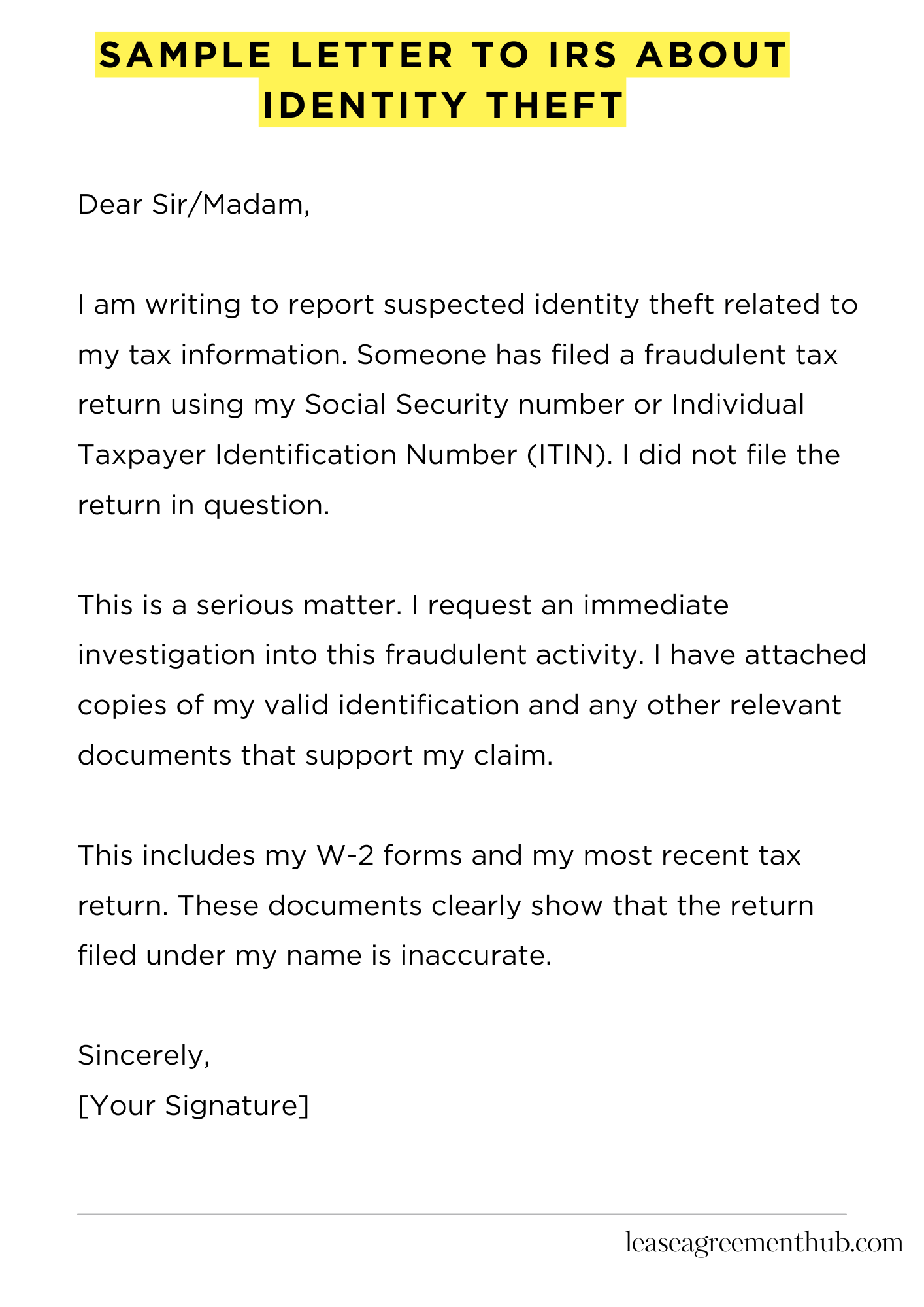A sample letter to the IRS about identity theft helps you report the crime. It explains what happened. It requests help resolving the issue.
This article gives you examples of these letters. We provide templates. These make writing your own letter easier.
Use our samples as a guide. Customize them to your situation. This helps you write a clear and effective letter.
Sample Letter to IRS About Identity Theft
[Your Name]
[Your Address]
[Your Phone Number]
[Your Email Address]
[Date]
Internal Revenue Service
[IRS Address]
Subject: Identity Theft – Taxpayer Identification Number [Your TIN]
Dear Sir/Madam,
I am writing to report suspected identity theft related to my tax information. Someone has filed a fraudulent tax return using my Social Security number or Individual Taxpayer Identification Number (ITIN). I did not file the return in question.
This is a serious matter. I request an immediate investigation into this fraudulent activity. I have attached copies of my valid identification and any other relevant documents that support my claim. This includes my W-2 forms and my most recent tax return. These documents clearly show that the return filed under my name is inaccurate.
I understand the importance of providing accurate information and I am cooperating fully with your investigation. Please contact me as soon as possible to discuss this further. I am available at your earliest convenience. My preferred method of contact is by phone.
Thank you for your time and attention to this urgent matter. I look forward to your prompt response and resolution.
Sincerely,
[Your Signature]

How to Write a Sample Letter to IRS About Identity Theft
Understanding the Gravity of the Situation
Identity theft is a pernicious crime, leaving victims vulnerable to financial ruin and protracted legal battles. Responding swiftly and decisively is paramount. A meticulously crafted letter to the IRS is your first, crucial step towards redress.
Gathering Your Arsenal: Essential Documentation
Before embarking on letter composition, amass irrefutable evidence. This includes copies of your tax returns, identification documents (driver’s license, passport), bank statements exhibiting unauthorized activity, and any correspondence received from the IRS regarding fraudulent tax filings. Don’t overlook anything; thoroughness is key.
Structuring Your Epistolary Assault: A Formal Approach
Employ a formal tone throughout your letter. Begin with your contact information and the date. Address your letter to the appropriate IRS department—likely the Identity Protection Specialized Unit (IPSU). Clearly state the purpose of your letter: reporting identity theft related to your tax filings. Concise yet comprehensive language is essential.
Articulating the Facts: A Chronological Narrative
Present a detailed, chronological account of events. When did you first suspect identity theft? What specific actions were taken without your authorization? Provide specific dates, amounts, and any identifying information concerning the fraudulent activity. This narrative must be both lucid and perspicuous.
Providing Irrefutable Proof: Supporting Your Claims
This section is pivotal. Attach copies of all supporting documents mentioned earlier. This evidentiary support substantiates your claims and lends credibility to your allegations. Each document should be clearly labeled and referenced within the body of your letter itself.
Concluding with a Call to Action: A Demand for Resolution
Conclude by requesting specific actions from the IRS. Demand an investigation into the fraudulent activity. Request a copy of the fraudulent return and all associated documents. State your desire for the revocation of the fraudulent filing and restitution for any financial losses incurred. Be assertive but remain respectful.
Post-Dispatch Procedures: The Ongoing Process
After sending your letter via certified mail with return receipt requested (for proof of delivery), retain copies of everything. Follow up with the IRS periodically if you don’t receive a response within a reasonable timeframe. Consider consulting a tax attorney if the situation becomes excessively complex or protracted.
FAQs about sample letter to IRS about identity theft
What information should I include in my letter to the IRS about identity theft?
Your letter should include your name, address, phone number, Social Security number, and a detailed description of the identity theft incident, including dates, amounts, and any relevant documentation. It should also clearly state that you are a victim of identity theft and request that the IRS investigate the fraudulent activity.
How do I prove to the IRS that I am a victim of identity theft?
Provide copies of any documentation that supports your claim, such as police reports, identity theft reports from credit bureaus (Equifax, Experian, TransUnion), and any correspondence you received related to the fraudulent activity. The more evidence you can provide, the stronger your case will be.
What should I do if the IRS doesn’t respond to my letter?
If you don’t receive a response within a reasonable timeframe (allow several weeks), follow up with a phone call to the IRS. Keep records of all communication with the agency.
Can I use a sample letter as a template, and if so, where can I find one?
Using a sample letter as a template is acceptable, but remember to personalize it with your specific details. Many reputable tax and legal websites offer sample letters; however, always verify the source’s credibility.
What if the fraudulent tax return was already filed and processed?
If a fraudulent tax return was already filed and processed, your letter should clearly state this and request immediate action to rectify the situation. You may need to provide additional documentation and be prepared for a more extensive investigation.
Related: